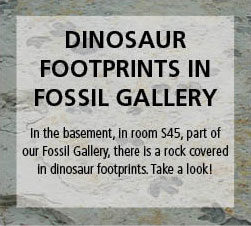GOOD IMPRESSIONS
The image below is a photo of the exhibit panel. Following it is a transcript of the panel.

Fossil trackways record an animal's activity at a specific time and place.
Footprints
made in damp or wet soil preserve best in the fossil record. It can be difficult to know which animal made them, unless the trackmaker's remains are preserved in the same place.
A trackway is a series of consecutive footprints.
Much can be learned from a trackway, such as whether the trackmaker's gait was narrow or wide, and whether it walked on four legs or two. A single fossil footprint is less informative.
If the height of a trackmaker's hip is known from fossil remains, its trackway can be used to calculate the animal's speed (based on the distance between consecutive prints of one foot) at the moment when the tracks were made.
Trackways of extinct dinosaurs show that they had narrow gaits. Some therapods ran at a speed of about 25 miles per hour. One thing trackways do
not
show is any indication that dinosaurs dragged their tails on the ground!
Some bipedal dinosaurs, such as
Camptosaurus
, walked on all fours at times, when moving slowly along. But
Camptosaurus
definitely ran on its hind legs when trying to escape a fierce predator like
Allosaurus
!
PICTURE CAPTIONS:
- Allosaurus
- Camptosaurus

DINOSAUR FOOTPRINTS IN FOSSIL GALLERY
In the basement, in room S45, part of our Fossil Gallery, there is a rock covered in donosaur footprints. Take a look! Click on image above to see Dinosaur Footprints page.